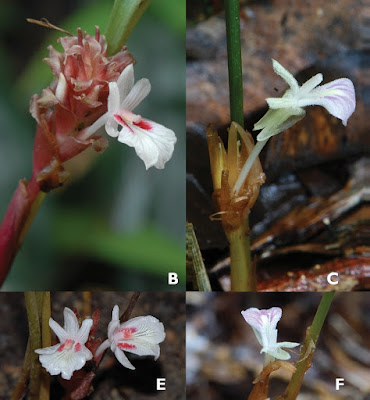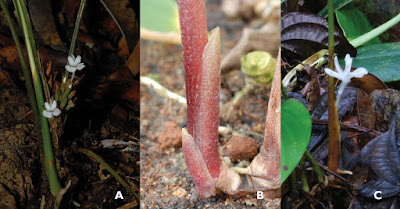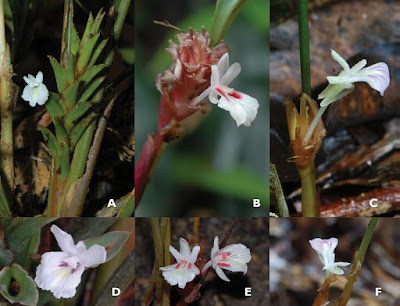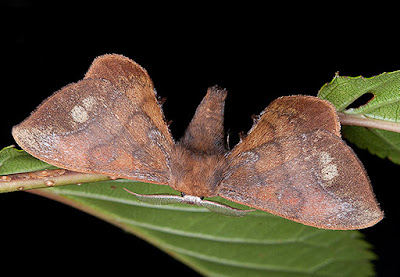[Most Recent Entries] [Calendar View]
Monday, December 5th, 2016
| Time | Event | ||||
| 3:54a | [Botany • 2016] Borneocola spp. • A New Genus (Zingiberaceae) from Borneo
Abstract A new genus from Borneo, Borneocola Y.Y.Sam, is described here. The genus currently contains eight species previously classified as members of the Scaphochlamys Baker. The finding is based on the results of the morphological and molecular studies of Scaphochlamys throughout its geographical range and its closely allied sister groups, Distichochlamys M.F.Newman and Myxochlamys A.Takano & Nagam. Borneocola is nested within the tribe Zingibereae and its monophyly is strongly supported by both ITS and matK sequence data. The genus is characterised by several thin, translucent and marcescent floral bracts, absence of coloured streaks on the labellum and capitate stigma with two dorsal knobs. The genus is distributed in northwest Borneo and all species are very rare and highly endemic. Keywords: Distichochlamys, Myxochlamys, Scaphochlamys, morphology, phylogeny, taxonomy Borneocola Y.Y.Sam, gen. nov. Diagnosis: Similar to Scaphochlamys and Myxochlamys. Borneocola has thin, translucent and marcescent floral bracts, absence of coloured streaks on labellum and two dorsal knobs on the stigma versus the coriaceous and persistent floral bracts, coloured streaks on labellum and absence of dorsal knobs on the stigma in Scaphochlamys. The mucilage on the floral bracts and the versatile anther of Myxochlamys are absent in Borneocola. Type species: Borneocola reticosus (Ridl.) Y.Y.Sam, comb. nov. Gastrochilus reticosa Ridl., J. Straits Branch Roy. Asiat. Soc. 44: 195 (1905). Morphology: The Borneocola and Scaphochlamys species look similar in their vegetative morphologies. They are mostly small-sized gingers without the conspicuous pseudostem, with one to several leaves arranged spirally and tightly on a very short stem at the base. So far, all the Borneocola species examined are unifoliate. Similarly, most of the Scaphochlamys species also bear one leaf except for several species which have leafy shoots composed of multiple leaves, for example, S. grandis, S. lanceolata, S. kunstleri, S. malaccana and S. minutiflora. The basal part of the leaves is covered with a few bladeless sheaths which are rather different for both groups in terms of their texture and colour. For Scaphochlamys, the sheaths are coriaceous, green, green with a red tinge or red and mostly persistent until the end of flowering (Figure 4A, B). On the other hand, the sheaths of Borneocola are thinner in texture with a lighter shade of green or brown. The thin sheaths normally dry up early (Figure 4C) and sometimes they are completely shredded during the time of flowering.
The inflorescences of Borneocola and Scaphochlamys are terminal, stalked and consisted of few to many floral bracts. The differences lie in the characteristics of the floral bracts and flowers. Borneocola species have thin, translucent, early decaying and marcescent floral bracts. The colours of the bracts can be pink, pale brown, pale or light green (Figure 5A). On the contrary, the bracts of Scaphochlamys are coriaceous and sometimes hard in texture. They are usually green, green tinged red, red or reddish brown and remain fresh throughout the flowering (Figure 5B, C). ..... Etymology: This new genus is named after the island of Borneo and -cola (Latin) means dweller or inhabitant. This is to recognise the extremely rich and unique biodiversity that is found in Borneo. Distribution: Borneo. The genus is currently known to occur only in the northwest and possibly central Borneo. Eight species are recorded from Sarawak, Malaysia and many more are undescribed. 1. Borneocola argenteus (R.M.Sm.) Y.Y.Sam, comb. nov. Scaphochlamys argentea R.M.Sm., Notes Roy. Bot. Gard. Edinburgh 44: 209 (1987). Scaphochlamys depressa Mas Izzaty, A.Ampeng & K.Meekiong, Folia Malaysiana 14(2): 19 (2013). 2. Borneocola biru (Meekiong) Y.Y.Sam, comb. nov. Scaphochlamys biru Meekiong, Folia Malaysiana 16(1): 37 (2015). 3. Borneocola calcicola (A.D.Poulsen & R.J.Searle) Y.Y.Sam, comb. nov. Scaphochlamys calcicola A.D.Poulsen & R.J.Searle, Gard. Bull. Singapore 57: 29 (2005). 4. Borneocola iporii (Meekiong & A.Ampeng) Y.Y.Sam, comb. nov. Scaphochlamys iporii Meekiong & A.Ampeng, Folia Malaysiana 12(1): 19 (2011). 5. Borneocola petiolatus (K.Schum.) Y.Y.Sam, comb. nov. Haplochorema petiolatum K.Schum. in Engler, Pflanzenr. IV, 46 (Heft 20): 90 (1904). Scaphochlamys petiolata (K.Schum.) R.M.Sm., Notes Roy. Bot. Gard. Edinburgh 44: 210 (1987). 6. Borneocola reticosus (Ridl.) Y.Y.Sam, comb. nov. Gastrochilus reticosa Ridl., J. Straits Branch Roy. Asiat. Soc. 44: 195 (1905). Boesenbergia reticosa (Ridl.) Merr., Bibl. Enum. Born. Pl. 122 (1921). Scaphochlamys reticosa (Ridl.) R.M.Sm., Notes Roy. Bot. Gard. Edinburgh 44: 209 (1987). 7. Borneocola salahuddinianus (Meekiong, A.Ampeng & Ipor) Y.Y.Sam, comb. nov. Scaphochlamys salahuddiniana Meekiong, A.Ampeng & Ipor, Folia Malaysiana 12(1): 22 (2011). 8. Borneocola stenophyllus (I.H.Ooi & S.Y.Wong) Y.Y.Sam, comb. nov. Scaphochlamys stenophylla I.H.Ooi & S.Y.Wong, Willdenowia 44(2): 241-245 (2014). Incompletely known species Scaphochlamys anomala (Hallier f.) R.J.Searle, Edinburgh J. Bot. 67: 85 (2010). Kaempferia anomala Hallier f., Bull. Herb. Boissier 6: 357 (1898). Gastrochilus anomalum (Hallier f.) K.Schum. in Engler, Pflanzenr. IV, 46 (Heft 20): 92 (1904). Boesenbergia anomala (Hallier f.) Schltr., Repert. Spec. Nov. Regni Veg. 12: 315 (1913). Gastrochilus hallieri (Hallier f.) Ridl., J. Straits Branch Roy. Asiat. Soc. 32: 109 (1899), nom. illegit. Yen Yen Sam, Atsuko Takano, Halijah Ibrahim, Eliška Záveská and Fazimah Aziz. 2016. Borneocola (Zingiberaceae), A New Genus from Borneo. PhytoKeys. 75; 31-55. DOI: 10.3897/phytokeys.75.9837 | ||||
| 4:01a | [Entomology • 2016] Andraca yauichui • A New Species (Bombycidae sensu lato, Lepidoptera) Endemic to mid Elevation Forests of Taiwan Abstract A new endemic, montane species of the genus Andraca, Andraca yauichui sp. nov., in Taiwan is described. It can be separated well from a lower montane, notable tea tree pest A. theae (Matsumura, 1909), based on morphological characters of adult, e.g. larger wingspan size, head vertex white rather than brown, valval apex truncate rather than bifurcate, and final instar larva, e.g. the presence of a pair of white spot on lateral part of each abdominal segment and a distinct short anal horn rather than the absence of two characters. The subgeneric placement of this new species in Andraca is also discussed. Keywords: Lepidoptera, Bombycidae sensu lato, Oberthuerinae, Oriental region, Theaceae, Symplocaceae
Distribution and bionomics. Endemic to Taiwan. Distributed in mid mountain ranges between 1721 to 2610 m, the adults occasionally occur from January to November. According to the breeding record by Mei-Yu Chen in mid-elevation of Central Mountain Range, Meifeng (ca. 2100 m), four final instar larvae were found on Eurya strigillosa (Theaceae) on 17th December, 2003, the emerging date of the first adult is 21th March, 2004. Etymology. The new species is dedicated to the late Dr. Yau-I Chu, who passed in March, 2015. He published amounts of scientific papers, general books for insect knowledge in his life, so continue to profoundly affect the development of entomology in Taiwan. Shipher Wu and Wei-Chun Chang. 2016. Andraca yauichui sp. n., A New Species Endemic to mid Elevation Forests of Taiwan (Bombycidae sensu lato, Lepidoptera). Zootaxa. 4200(4); 515–522. DOI: 10.11646/zootaxa.4200.4.4 | ||||
| 5:36a | [Herpetology • 2016] Stenocercus omari • A New Species of Iguanid Lizard, Genus Stenocercus (Squamata, Iguania), from the Central Andes in Peru
Abstract We describe a new species of Stenocercus from the montane forest of the right margin of the Marañón river in the northern portion of the Central Andes in northern Peru (Amazonas and La Libertad departments), at elevations ranging from 2300 to 3035 m. Stenocercus omari sp. nov. differs from other Stenocercus species, with the exception of S. amydrorhytus, S. chrysopygus, S. cupreus, S. johaberfellneri, S. latebrosus, S. melanopygus, S. modestus, S. ornatissimus, S. orientalis, and S. stigmosus, by having granular scales on the posterior surfaces of thighs, a conspicuous antehumeral fold and by lacking a vertebral crest. However, Stenocercus omari sp. nov. is easily distinguished from the aforementioned species, except S. orientalis, by the presence of prominently keeled dorsal head scales. The new species differs from S. orientalis by lacking a prominent oblique neck fold and by having a distinct deep postfemoral mite pocket. Keywords: Reptilia, Amazonas department, Central Andes, clutch size, Marañón river, La Libertad department Pablo J. Venegas, Lourdes Y. Echevarría, Karla García-Burneo and Claudia Koch. 2016. A New Species of Iguanid Lizard, Genus Stenocercus (Squamata, Iguania), from the Central Andes in Peru. Zootaxa. 4205(1); 52–64. DOI: 10.11646/zootaxa.4205.1.4 |
| << Previous Day |
2016/12/05 [Calendar] |
Next Day >> |








